
Clarkia is a genus within the flowering plant family Onagraceae. Over 40 species are currently classified in Clarkia; almost all are native to western North America, though one species is native to South America.

Clarkia amoena is a flowering plant native to western North America, found in coastal hills and mountains from British Columbia south to the San Francisco Bay Area.
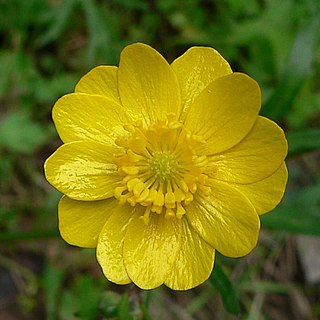
Ranunculus californicus, commonly known as the California buttercup, is a flowering plant of the buttercup family Ranunculaceae. It is a native of California, where it is common in many habitats, including chaparral and woodlands.

Clarkia rubicunda is a flowering plant endemic to California. It is found mostly on the Central Coast part of the state. The plant is known by the common names Ruby Chalice Clarkia and Farewell to Spring.

Clarkia gracilis is a species of wildflower known by the common name slender clarkia. This plant is native to the US states of California, Oregon, and Washington, where it is found in coastal, foothill, valley, and low-elevation mountain habitats. The plant is variable across subspecies but is generally an erect slender stem with a few sparse, narrow leaves several centimeters long. It bears an inflorescence of drooping buds which open into bowl-shaped flowers with pinkish lavender petals 1 to 4 centimeters long and bearing a red or white splotch which can appear in the center or at the base of the petal, depending on the subspecies.
Clarkia lingulata is a rare species of wildflower known by the common name Merced clarkia. This plant is endemic to Mariposa County, California, where it is known from only two sites near the Merced River.
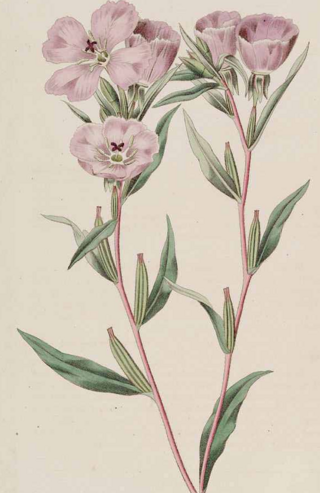
Clarkia purpurea is a species of wildflower known by the common names winecup clarkia, winecup fairyfan, and purple clarkia.
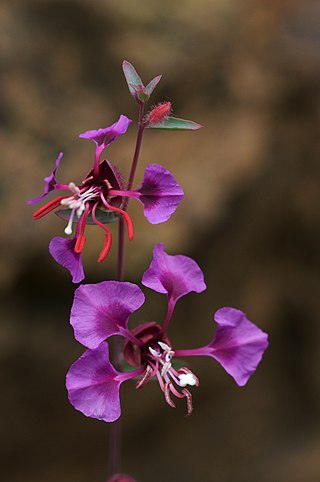
Clarkia unguiculata is a species of wildflower known by the common name elegant clarkia or mountain garland. This plant is endemic to California, where it is found in many woodland habitats. Specifically it is common on the forest floor of many oak woodlands, along with typical understory wildflowers that include Calochortus luteus, Cynoglossum grande and Delphinium variegatum. C. unguiculata presents a spindly, hairless, waxy stem not exceeding a meter in height and bears occasional narrow leaves. The showy flowers have hairy, fused sepals forming a cup beneath the corolla, and four petals each one to 2.5 centimeters long. The paddle-like petals are a shade of pink to reddish to purple and are slender and diamond-shaped or triangular. There are eight long stamens, the outer four of which have large red anthers. The stigma protrudes from the flower and can be quite large. Flowers of the genus Clarkia are primarily pollinated by specialist bees found in their native habitat "Clarkias independently developed self-pollination in 12 lineages."

Clarkia cylindrica is a species of flowering plant in the evening primrose family known by the common name speckled fairyfan, or speckled clarkia.
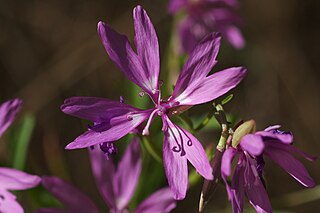
Clarkia biloba is a species of flowering plant in the evening primrose family known by the common name twolobe clarkia and two lobed clarkia.
Clarkia borealis is a rare species of flowering plant in the evening primrose family known by the common name northern clarkia. It is endemic to California, where it is known from the forests of the southern Klamath Range and the southernmost Cascade Range foothills. It is an annual herb growing an erect, slender stem. The leaves are oval in shape and borne on short petioles. The top of the stem is occupied by the inflorescence, in which the lowest flowers open first and hanging, pointed flower buds occur at nodes at the top. The sepals separate as the flower blooms, revealing purplish pink petals. Each petal is between 1 and two centimeters long, elongated triangular to semicircular in shape, and sometimes flecked with dark purple. There are 8 stamens with anthers bearing blue-gray pollen, and a protruding stigma.
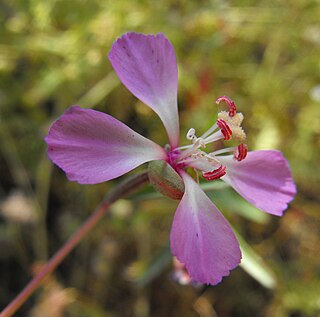
Clarkia delicata is a rare species of flowering plant in the evening primrose family known by the common names Campo clarkia and delicate clarkia. It is native to northern Baja California and adjacent San Diego County, California, where it grows in the woodland and chaparral of the Peninsular Ranges. This is an annual herb producing an erect stem just over half a meter in maximum height. The leaves are oval or widely lance-shaped, up to 4 centimeters long, and borne on very short petioles. The top of the stem is occupied by the inflorescence, in which the lower flowers open while the upper buds hang closed. The sepals remain fused as the flower blooms from one side. Each unlobed oval petal is about a centimeter long and pink to pinkish-lavender. There are 8 stamens, some with large orange anthers and some with smaller, paler anthers. There is also a protruding stigma with four large, fuzzy lobes.

Clarkia franciscana is a rare species of flowering plant in the evening primrose family known by the common name Presidio clarkia. It is endemic to the San Francisco Bay Area of California, where it is known only from two populations at the Presidio of San Francisco and three occurrences in Oakland. The plant is known only from serpentine soils.

Clarkia imbricata is a rare species of flowering plant in the evening primrose family known by the common name Vine Hill clarkia. It is endemic to Sonoma County, California, where it is known from only one remaining natural occurrence near Vine Hill. A second natural population located on private land was extirpated when the owners plowed up the soil crust. The California Native Plant Society has established a third population from cuttings and is tending it in a reserve. This is a federally listed endangered species.
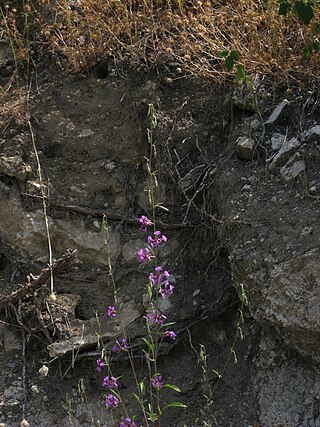
Clarkia mosquinii is a rare species of flowering plant in the evening primrose family known by the common name Mosquin's clarkia. It is endemic to California, where it is known only from the northern Sierra Nevada foothills at the border between Butte and Plumas Counties. It was thought to be extinct until it was rediscovered in 1991. It is an erect annual herb often exceeding half a meter in height. The oval or lance-shaped leaves are 2 to 5 centimeters long. The inflorescence bears opening flowers below a series of clusters of closed, hanging flower buds. The sepals all separate as the flower blooms. The diamond-shaped petals are one to two centimeters long light to medium purple in color, and sometimes speckled with reddish purple.
Clarkia rostrata is a species of flowering plant in the evening primrose family known by the common name beaked clarkia.
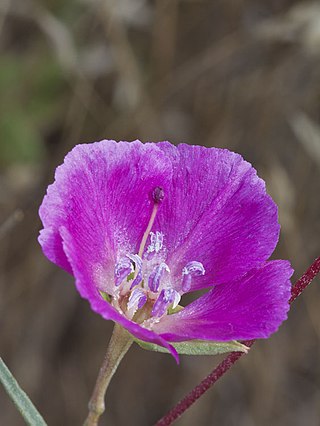
Clarkia speciosa is a species of flowering plant in the evening primrose family known by the common name redspot clarkia. It is endemic to California, where it is known from the Central Coast and mountains and from the Sierra Nevada foothills. The plant is variable across its intergrading subspecies, taking a decumbent to erect form with a stem up to about half a meter long. The open or dense inflorescence has opening flowers and several closed buds. As the bud opens the sepals all separate from each other. The fan-shaped petals are up to 2.5 centimeters long and may be lavender to pink to deep red, sometimes fading to white or yellowish at the base. There is sometimes, but not always, a large bright red spot near the middle of the petal.

Clarkia springvillensis is a rare species of flowering plant in the evening primrose family known by the common name Springville clarkia. It is endemic to central Tulare County, California, where it is known from fewer than 20 occurrences around Springville. It is a federally listed threatened species.
Clarkia tembloriensis is a rare species of flowering plant in the evening primrose family, known by the common name Temblor Range clarkia and belonging to the Onagraceae family.













